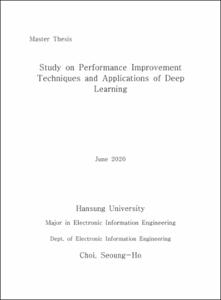Study on Performance Improvement Techniques and Applications of Deep Learning
= 딥 러닝의 성능 향상 기법 및 응용에 관한 연구
- Type
- Thesis
- Department
- 대학원 전자정보공학과
- Issued Date
- 2020
- Publisher
- 한성대학교 대학원
- Keyword
- deeplearning; performance; improvement; application; technology
- Files in This Item:
-
-
Download
 200000334126.pdf
기타 데이터 / 8.61 MB / Adobe PDF
200000334126.pdf
기타 데이터 / 8.61 MB / Adobe PDF
-
Items in Repository are protected by copyright, with all rights reserved, unless otherwise indicated.